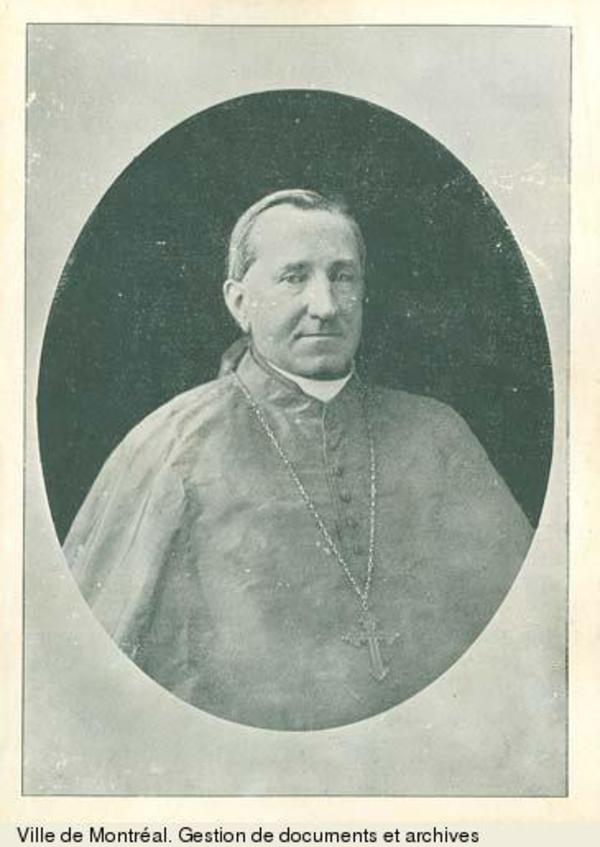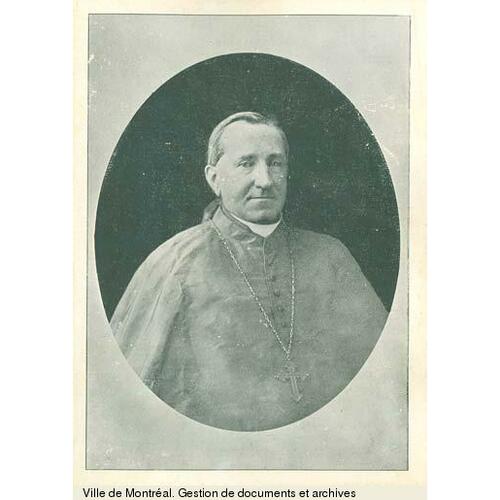
Source: Link
CLEARY, JAMES VINCENT, Roman Catholic priest and archbishop; b. 18 Sept. 1828 in Dungarvan, County Waterford (Republic of Ireland), son of Thomas Cleary and Margaret O’Brien; d. 24 Feb. 1898 in Kingston, Ont.
James Vincent Cleary was born into a devout Catholic family of moderate means. He received his elementary education in a select private school in his native town. At the age of 15, having completed the English and classical curriculum, he was sent by his parents to Rome to study for the priesthood. Because of an increase in the endowment to Maynooth seminary near Dublin in 1845, he was recalled to Ireland. After five years of study at Maynooth, he was ordained on 19 Sept. 1851. Further study in Salamanca, Spain, ended in 1854 when he returned to Ireland as professor of dogmatic theology and biblical exegesis at St John’s College in Waterford. Nine years later the Catholic university in Ireland, which did not have a royal charter, decided to exercise its papal charter by granting a theological degree. Cleary was chosen to undergo the required three days of rigorous public examination and received the university’s first doctorate of divinity. In 1873 he was appointed president of St John’s College, and three years later he became vicar general of the diocese of Waterford and parish priest of Dungarvan.
On 1 Oct. 1880 Pope Leo XIII proclaimed Cleary’s elevation to the position of bishop of Kingston, succeeding John O’Brien, who had died suddenly the previous year. Consecrated on 21 November in Rome, the new bishop returned to Ireland to wind up affairs before setting sail for Canada, where he was formally installed in his diocese on 7 April 1881. Though he was given a large and enthusiastic reception, not everyone was pleased by the appointment. Representations were made to Rome because a non-Canadian had been chosen rather than a local prospect.
Cleary soon discovered that his diocese was greatly in need of his administrative skills as well as his teaching abilities. Neglect and abuses of church discipline had gone unchecked and much had to be done to put the diocese on a sound financial footing. He consolidated the diocesan debts and arranged for a loan using property as collateral. In a series of brilliant pastoral letters beginning in May 1881, Bishop Cleary instructed clergy and laity alike on a variety of topics from the diocesan debt to the sanctification of the Christian household. Where instruction proved ineffective, he showed himself quite capable of pursuing and applying the remedies of law, both civil and ecclesiastic. He quickly earned respect and loyalty. During his 18-year reign he initiated, or saw completed, nearly 40 churches in the diocese, many with the aid of the noted architect Joseph Connolly of Toronto. He oversaw major alterations to St Mary’s Cathedral in Kingston, including the addition in 1890 of St James Chapel. Between 1883 and 1895 he had installed in the cathedral a set of stained glass windows (unparalleled in Ontario and possibly in Canada) that he had designed.
Active in national politics in Ireland, Cleary sought to avoid party politics in Canada. Yet he did not hesitate to intervene if he thought the interests of the Catholic Church were at stake. This stance was especially true of his unflinching commitment to Catholic education. It occasioned a notable series of highly publicized confrontations with Principal George Monro Grant* of Queen’s College as well as with William Ralph Meredith*, leader of the Conservative opposition in Ontario. Cleary would be equally uncompromising in fidelity to principle when instructing clergy and laity, and he demanded a like response. He did not hesitate to employ his full authority, including the use of excommunication, in confronting the recalcitrant. Not even his fellow bishops were immune. Cleary took great exception to what he saw as too great an accommodation on the part of Archbishop John Joseph Lynch* of Toronto to the provincial Liberal government of Oliver Mowat* in December 1884 concerning the introduction of Bible readings and prayers in public schools [see Christopher Finlay Fraser].
Cleary’s commitment to Catholic education often brought criticism from such influential quarters as the Toronto Globe and the Toronto Daily Mail and the British Whig in Kingston. But, as the Globe was to acknowledge at his death, these were “passages at arms . . . such battles as men may fight in a free country without ill-will and without leaving rankling wounds behind.” Praise was also forthcoming, from Archbishop Adélard Langevin* of St Boniface in 1895 during the Manitoba school question and from other bishops who felt encouraged by Cleary’s lucid and energetic positions.
Cleary’s great achievement in education was to come late in his career, after his elevation to archbishop, when Regiopolis College reopened in September 1896. This institution, established by Bishop Alexander McDonell* almost 60 years earlier as a seminary and classical school, had closed in 1869. In 1891 Archbishop Cleary sold off the old college property to the Religious Hospitallers of St Joseph for the Hôtel Dieu hospital. He bought a building on King Street, renovated it, reactivated the college’s charter, and in November ordered a diocese-wide collection to support it.
On 28 July 1889 the ecclesiastical province of Kingston had been created and Cleary had become the first archbishop of Kingston. In part, the archiepiscopal dignity was a tribute to the see of Kingston as the oldest diocese in English Canada, but it was also a tribute to the ability and achievements of Cleary himself. The latter part of his reign was dominated in some measure by efforts to manage and retire the diocesan debt.
Never in robust health, the archbishop suffered from atheroma and in 1896 his physical condition had deteriorated to the point that rest was prescribed. Late that year he journeyed to Atlantic City and Baltimore to escape the harsh Canadian winter. He returned home, partly restored, but his health began to deteriorate again, and it became obvious that he was losing the battle with his illness. He slipped into a coma on 23 Feb. 1898 and died the following day. His body was laid in state in the archbishop’s residence until it was transferred to St Mary’s Cathedral, where a pontifical requiem mass was celebrated on 1 March by Bishop Richard Alphonsus O’Connor of Peterborough before an impressive number of clerical and civic dignitaries. The archbishop’s body was interred in St James Chapel.
Tributes came from across Canada and the United States. They are best summed up in the tribute of the Kingston Daily News: “Perhaps he had some of the drawbacks as well as advantages of genius. Certainly he had a keen sense of humour, and we are inclined to think he hugely enjoyed the furore produced by some of his pastoral deliverances. . . . Great as a scholar, great as a polemic theologian, great as an administrator, the deceased prelate will long be remembered with respect and affection by his fellow-citizens in Kingston, who can scarcely expect for many years to come to see his like again.”
Arch. of the Archdiocese of Kingston (Kingston, Ont.), F (J. V. Cleary papers); St Mary’s Cathedral (Kingston), reg. of baptisms, marriages, and burials. Canadian Freeman (Kingston), 2 March 1898. Catholic Register (Toronto), 3 March 1898. Daily British Whig, 26 Feb. 1898. Globe, 2 March 1898. Weekly British Whig (Kingston), 24, 26 Feb., 3 March 1898. Canadian album (Cochrane and Hopkins), 2: 490–91. Canadian men and women of the time (Morgan; 1898). Cyclopædia of Canadian biog. (Rose and Charlesworth), 1: 642–50. L. J. Flynn, Built on a rock; the story of the Roman Catholic Church in Kingston, 1826–1976 (Kingston, 1976).
Cite This Article
Brian J. Price, “CLEARY, JAMES VINCENT,” in Dictionary of Canadian Biography, vol. 12, University of Toronto/Université Laval, 2003–, accessed December 16, 2025, https://www.biographi.ca/en/bio/cleary_james_vincent_12E.html.
The citation above shows the format for footnotes and endnotes according to the Chicago manual of style (16th edition). Information to be used in other citation formats:
| Permalink: | https://www.biographi.ca/en/bio/cleary_james_vincent_12E.html |
| Author of Article: | Brian J. Price |
| Title of Article: | CLEARY, JAMES VINCENT |
| Publication Name: | Dictionary of Canadian Biography, vol. 12 |
| Publisher: | University of Toronto/Université Laval |
| Year of publication: | 1990 |
| Year of revision: | 1990 |
| Access Date: | December 16, 2025 |




